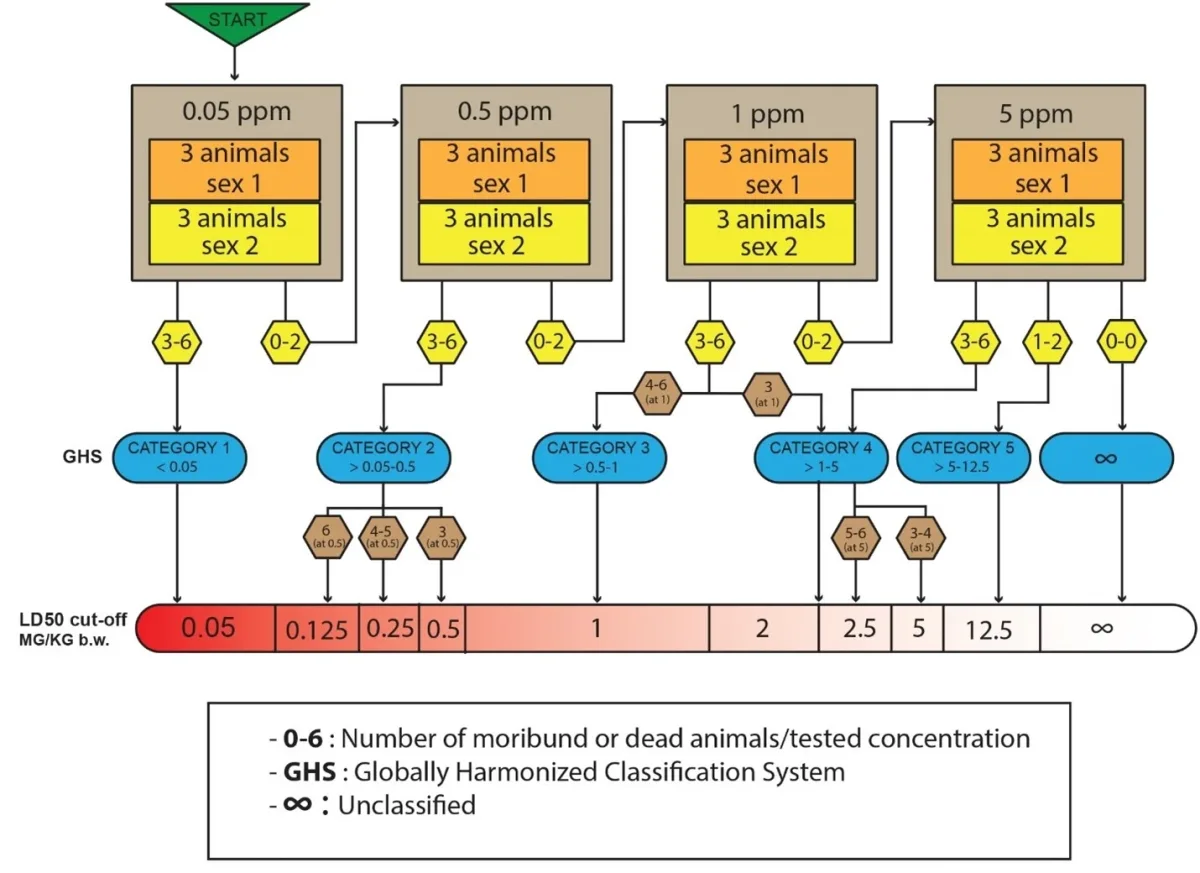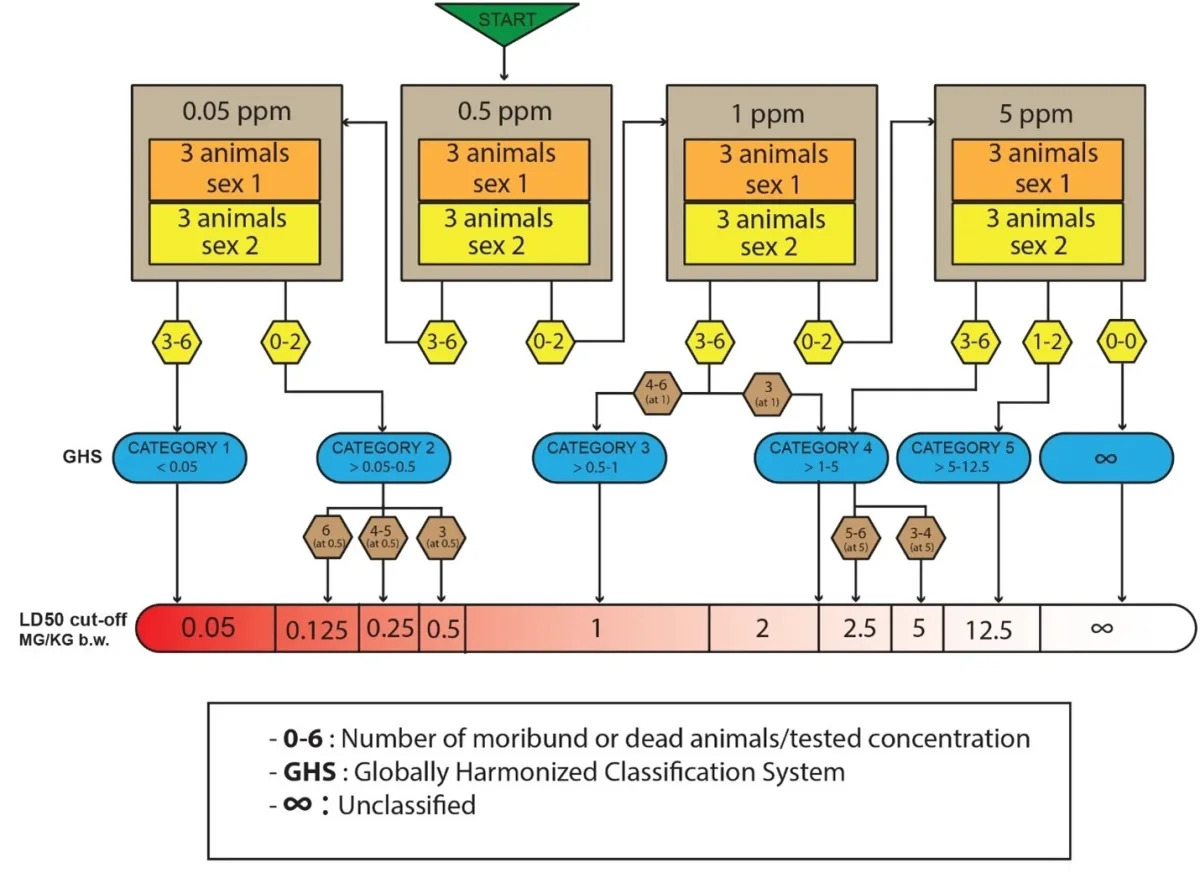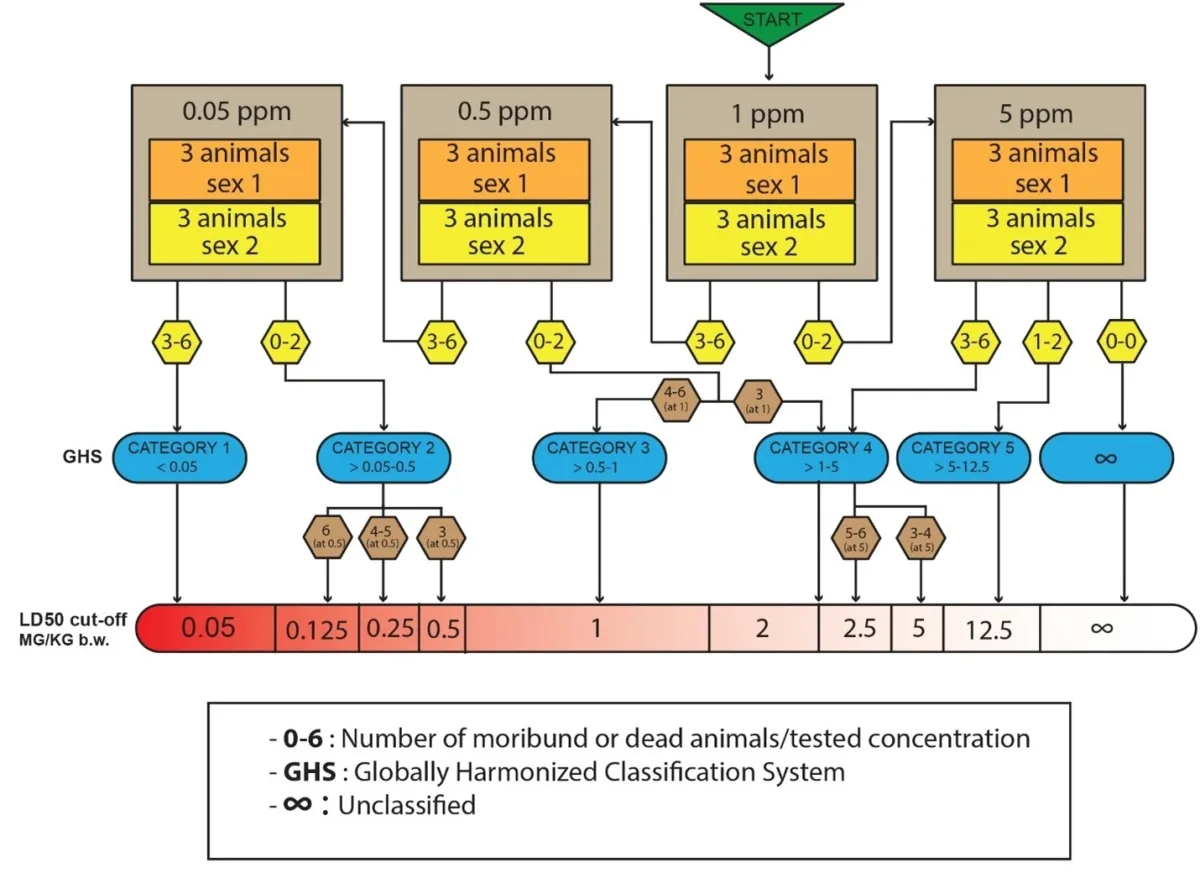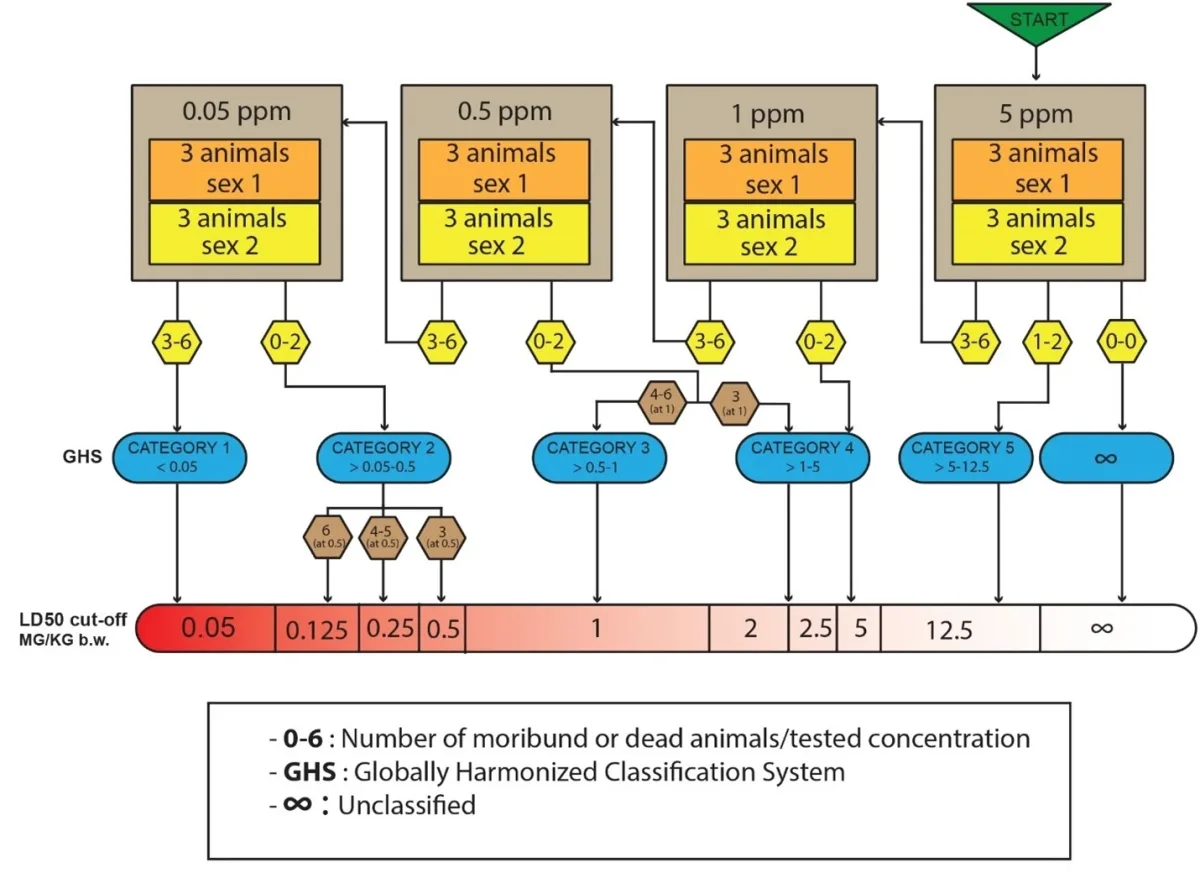
آزمون سمیت سیستمیک حاد تنفسی | Acute Inhalation Systemic Toxicity
تست سمیت سیستمیک حاد تنفسی | Acute Inhalation Toxicity
تست سمیت سیستمیک حاد با استفاده از يك مدل حیوانی مناسب جهت برآوردن الزامات زیست سازگاری و ارزیابی ریسک خطرات سمیت (toxicological risk assessment) تجهیزات پزشکی (medical devices)، داروها (pharmaceuticals)، سم و آفت کش (pesticides)، محصولات آرایشی و بهداشتی (cosmetics)، مواد شیمیایی صنعتی (chemicals) و محصولات مصرفی (consumer products) بکار می رود.
آزمون سمیت سیستمیک حاد استنشاقی، جهت ارزیابی پتانسیل سمیت حاد و محاسبه دوز متوسط کشنده (LD50 ) محدوده وسیعی از مواد، محصولات پزشکی و دارو هایی که به شکل اسپری تجویز می شوند و یا احتمال تماس آن ها با سیستم تنفسی انسان در کاربری بالینی وجود دارد بکار می رود. آزمون سمیت حاد یک تخمینی کلی از ماهیت سمی نمونه آزمایشی را مشخص می کند و همچنین نتایج حاصل از آن جهت تعیین دوز شروع سایر آزمونهای سمیت مانند آزمون سمیت سیستمیک تحت حاد، آزمون سمیت سیستمیک تحت مزمن و آزمون سمیت سیستمیک مزمن استفاده خواهد شد.
در مجموعه آزمایشگاه های سنجش و پایش کیاژن فارما، آزمون سمیت سیستمیک حاد تنفسی بر اساس استاندارد OECD-403 و به روش تماس کل بدن (whole-body inhalation exposure) انجام می شود.
توضیحات محصول
#آزمون سمیت سیستمیک حاد تنفسی#آزمون سمیت حاد سیستمیک تنفسی#آزمون سمیت حاد تنفسی#آزمون سیستمیک حاد تنفسی#Hcl,k sldj phn jktsd#Hcl,k sldj phn hsjkahrd#آزمون سمیت سیستمیک حاد استنشاقی#آزمون سمیت حاد سیستمیک استنشاقی#آزمون سمیت حاد استنشاقی#آزمون سیستمیک حاد استنشاقی#acute inhalation toxicity tests
آزمون سمیت سیستمیک حاد تنفسی | Acute Inhalation Toxicity
آزمون سمیت سیستمیک حاد استنشاقی، جهت ارزیابی پتانسیل سمیت حاد و محاسبه دوز متوسط کشنده (LD50 ) محدوده وسیعی از مواد و محصولات شامل دارو های تنفسی، آفت کش، سم و مواد شیمیایی صنعتی که احتمال تماس آن ها با سیستم تنفسی انسان وجود دارد، در بازه ۱۴ روزه پس از تیمار بکار می رود. آزمون سمیت حاد یک تخمینی کلی از ماهیت سمی نمونه آزمایشی را مشخص می کند و همچنین نتایج حاصل از آن جهت تعیین دوز شروع سایر آزمون های سمیت مانند آزمون سمیت سیستمیک تحت حاد، آزمون سمیت سیستمیک تحت مزمن و آزمون سمیت سیستمیک مزمن استفاده خواهد شد.
#تست سمیت سیستمیک حاد تنفسی#تست سمیت حاد سیستمیک تنفسی#تست سمیت حاد تنفسی#تست سیستمیک حاد تنفسی#jsj sldj sdsjld; phn hsjkahrd#jsj sldj sdsjld; phn jktsd#تست سمیت سیستمیک حاد استنشاقی#تست سمیت حاد سیستمیک استنشاقی#تست سمیت حاد استنشاقی#تست سیستمیک حاد استنشاقی#acute inhalation systemic toxicity tests
روش کار
در مجموعه آزمایشگاه های سنجش و پایش کیاژن فارما، آزمون سمیت حاد تنفسی، بر روی موش آزمایشگاهی نژاد سوری (NMRI) و یا رت آزمایشگاهی انجام می شود. آزمون نیاز به گروه کنترل ندارد و فقط زمانیکه از حامل / حلال غیر آبی جهت آماده سازی آزمونه استفاده شده باشد، یک آزمایش مقدماتی مشابه روش بکار رفته در گروه تیمار، با ناقل انجام خواهد شد.
پیش از شروع کار، ابتدا مطالعات نظری و گذشته نگر از نظر موارد زیر بر روی ماده آزمایشی و یا محصولات مشابه انجام خواهد شد تا اطلاعات کلی در مورد سمیت ماده آزمایشی و دوز شروع آزمون حاصل شود. کلیه موارد بر اساس مولفه ها و معیارهای استاندارد ISO 10993-1 انتخاب و ارزیابی خواهند شد.
- برگه پرسشنامه پر شده توسط متقاضی در خصوص ویژگی های محصول (intended use/device characteristics)
- فرآیند مدیریت ریسک مواد (risk management process)
- تحلیل ریسک مواد تشکیل دهنده محصول (risk analysis)
- شناسایی خطرات بیولوژیک محصول (biological hazard identification)
- ارزیابی در معرض قرار گیری محصول (exposure assessment)
- کنترل ریسک مواد تشکیل دهنده محصول (risk control)
- اطلاعات پس از تولید محصول (post-production information)
مطالعات نظری پیش از شروع تستهای درونتنی، یک فعالیت علمی و بسیار مهم است که جهت توجیه و برنامه ریزی صحیح جهت ارزیابی خطرات بیولوژیکی یک ماده / وسیله و همچنین جهت کسب اطلاعات ضروری برای رعایت اصول اخلاقی کار با حیوانات آزمایشی (اصول سه گانه) و انتخاب روش مناسب جهت آماده سازی نمونه باید انجام شود.
چنین مطالعاتی مشخص می کند که آیا داده های موجود، برای نشان دادن ایمنی بیولوژیکی ماده / وسیله / دستگاه پزشکی مورد نظر، بدون نیاز به انجام آزمون های درون تنی، کافی است یا خیر؟! اگر پس از مطالعات تئوری، داده ها از نظر سطوح ایمن مواجهه بالینی، قابل قبول ارزیابی شد و یا اگر داده های سم شناسی حاکی از امکان انجام آزمون های حیوانی باشد، بخش حیوانی کیاژن فارما اقدام به انجام تست درون تنی خواهد کرد.
#آزمون سمیت سیستمیک حاد تنفسی#آزمون سمیت حاد سیستمیک تنفسی#آزمون سمیت حاد تنفسی#آزمون سیستمیک حاد تنفسی#Hcl,k sldj phn jktsd#Hcl,k sldj phn hsjkahrd#آزمون سمیت سیستمیک حاد استنشاقی#آزمون سمیت حاد سیستمیک استنشاقی#آزمون سمیت حاد استنشاقی#آزمون سیستمیک حاد استنشاقی#acute inhalation toxicity tests
آزمون مقدماتی | Pilot Study
در بخش حیوانی مجموعه آزمایشگاه های سنجش و پایش کیاژن فارما، هدف از انجام آزمون مقدماتی، مشخص کردن دوز مناسب آزمایه جهت شروع آزمون اصلی است. هنگامیکه بر اساس مطالعات نظری انجام شده پیش از شروع تست، اطلاعات کافی در مورد نمونه وجود ندارد، یک تست مقدماتی مطابق روش زیر جهت یافتن دوز شروع و با استفاده از تعداد حداقلی از حیوانات انجام می شود:
- موش های سوری (NMRI) ۶ تا ۸ هفته و با میانگین وزن ۲۰ تا ۳۰ گرم جهت انجام آزمون آماده خواهند شد.
- حیوانات به صورت مرحله ای تحت تیمار با غلظت های ثابت 0.05، 0.5، 1 و 5 پی پی ام (ppm) از ماده آزمایشی قرار خواهند گرفت و سپس از نظر علایم سمیت بررسی و سپس دوز مناسب جهت شروع آزمون اصلی انتخاب خواهد شد.
#تست سمیت سیستمیک حاد تنفسی#تست سمیت حاد سیستمیک تنفسی#تست سمیت حاد تنفسی#تست سیستمیک حاد تنفسی#jsj sldj sdsjld; phn hsjkahrd#jsj sldj sdsjld; phn jktsd#تست سمیت سیستمیک حاد استنشاقی#تست سمیت حاد سیستمیک استنشاقی#تست سمیت حاد استنشاقی#تست سیستمیک حاد استنشاقی#acute inhalation systemic toxicity tests
#آزمون سمیت سیستمیک حاد تنفسی#آزمون سمیت حاد سیستمیک تنفسی#آزمون سمیت حاد تنفسی#آزمون سیستمیک حاد تنفسی#Hcl,k sldj phn jktsd#Hcl,k sldj phn hsjkahrd#آزمون سمیت سیستمیک حاد استنشاقی#آزمون سمیت حاد سیستمیک استنشاقی#آزمون سمیت حاد استنشاقی#آزمون سیستمیک حاد استنشاقی#acute inhalation toxicity tests
آزمون اصلی | Main Study
آزمون اصلی با استفاده از روش تماس کل بدن (whole-body inhalation exposure) انجام خواهد شد، بدین منظور حیوانات به مدت ۴ ساعت تحت تیمار با آئروسل های ایجاد شده از نمونه آزمایشی قرار خواهند گرفت.
- ۶ موش آزمایشگاهی با سن ۸ تا ۱۲ هفته جهت هر یک از گروه های تیمار (دوز های نمونه) آماده و علامت گذاری خواهند شد.
- آزمون بر اساس فلوچارت های زیر و به صورت مرحله ای تا رسیدن به هدف آزمون ادامه خواهد یافت.
- در نهایت دوز سمی ماده آزمایشی و دسته GHS آن گزارش خواهد شد.
- طول مدت مشاهدات حیوانات تحت آزمون، از زمان شروع تا پایان آزمون، حداقل به مدت ۱۴ روز است.
- در پایان آزمون، کلیه حیوانات بر اساس موازین اخلاقی، معدوم و کالبدگشایی شده و اندام های داخلی بدن، خصوصا بافت ریه حیوانات، مورد ارزیابی دقیق ماکروسکوپی و میکروسکوپی قرار خواهد گرفت.
#تست سمیت سیستمیک حاد تنفسی#تست سمیت حاد سیستمیک تنفسی#تست سمیت حاد تنفسی#تست سیستمیک حاد تنفسی#jsj sldj sdsjld; phn hsjkahrd#jsj sldj sdsjld; phn jktsd#تست سمیت سیستمیک حاد استنشاقی#تست سمیت حاد سیستمیک استنشاقی#تست سمیت حاد استنشاقی#تست سیستمیک حاد استنشاقی#acute inhalation systemic toxicity tests
#آزمون سمیت سیستمیک حاد تنفسی#آزمون سمیت حاد سیستمیک تنفسی#آزمون سمیت حاد تنفسی#آزمون سیستمیک حاد تنفسی#Hcl,k sldj phn jktsd#Hcl,k sldj phn hsjkahrd#آزمون سمیت سیستمیک حاد استنشاقی#آزمون سمیت حاد سیستمیک استنشاقی#آزمون سمیت حاد استنشاقی#آزمون سیستمیک حاد استنشاقی#acute inhalation toxicity tests
آزمون تعیین حد | Limit Test
در بخش حیوانی کیاژن فارما، به طور استثناء زمانیکه الزامات قانونی مطرح باشد، از دوز های بالاتر از 5 پی پی ام تنها در موارد زیر، به شرط اینکه در دوز 5 پی پی ام آزمون اصلی، علائم سمیت مشاهده نشده باشد، آزمایش تعیین حد انجام خواهد شد:
- شواهدی دال بر سمی بودن آزمونه در دوز های بالاتر از حد مجاز (regulatory limit doses) وجود داشته باشد که برای جمعیت های آسیب پذیر خطرناک باشد.
- نمونه مورد آزمون، تاثیر مستقیم بر سلامت انسان، حیوان و یا محیط زیست داشته باشد.
- در مواردیکه اطلاعاتی از ماده آزمایشی موجود نیست و یا احتمال سمی بودن آن وجود دارد، نباید تست تعیین حد انجام شود.
#تست سمیت سیستمیک حاد تنفسی#تست سمیت حاد سیستمیک تنفسی#تست سمیت حاد تنفسی#تست سیستمیک حاد تنفسی#jsj sldj sdsjld; phn hsjkahrd#jsj sldj sdsjld; phn jktsd#تست سمیت سیستمیک حاد استنشاقی#تست سمیت حاد سیستمیک استنشاقی#تست سمیت حاد استنشاقی#تست سیستمیک حاد استنشاقی#acute inhalation systemic toxicity tests




استاندارد های زیست سازگاری | References
ISO 10993-2: Biological Evaluation of Medical Devices – Animal welfare requirements.
ISO 10993-5: Biological Evaluation of Medical Devices – Tests for in vitro cytotoxicity.
ISO 10993-6: Biological Evaluation of Medical Devices – Tests for local effects after implantation.
ISO 10993-7: Biological Evaluation of Medical Devices – Ethylene oxide sterilization residuals.
ISO 10993-10: Biological Evaluation of Medical Devices – Tests for skin sensitization.
ISO 10993-11: Biological Evaluation of Medical Devices – Tests for systemic toxicity.
ISO 10993-12: Biological Evaluation of Medical Devices – Sample preparation and reference materials.
ISO 10993-22: Biological Evaluation of Medical Devices – Guidance on nanomaterials.
ISO 10993-23: Biological Evaluation of Medical Devices – Tests for irritation.
OECD Test No. 401: Guidelines for the Testing of Chemicals – Acute Oral Toxicity.
OECD Test No. 402: Guidelines for the Testing of Chemicals – Acute Dermal Toxicity.
OECD Test No. 403: Guidelines for the Testing of Chemicals – Acute Inhalation Toxicity.
OECD Test No. 404: Guidelines for the Testing of Chemicals – Acute Dermal Irritation/Corrosion.
OECD Test No. 405: Guidelines for the Testing of Chemicals – Acute Eye Irritation/Corrosion.
OECD Test No. 406: Guidelines for the Testing of Chemicals – Skin Sensitisation.
OECD Test No. 414: Guidelines for the Testing of Chemicals – Prenatal Developmental Toxicity Study.
OECD Test No. 416: Guidelines for the Testing of Chemicals – Two-Generation Reproduction Toxicity.
OECD Test No. 417: Guidelines for the Testing of Chemicals – Toxicokinetics.
OECD Test No. 424: Guidelines for the Testing of Chemicals – Neurotoxicity Study in Rodents.
OECD Test No. 426: Guidelines for the Testing of Chemicals – Developmental Neurotoxicity Study.
OECD Test No. 427: Guidelines for the Testing of Chemicals – Skin Absorption: In Vivo Method.
OECD Test No. 428: Guidelines for the Testing of Chemicals – Skin Absorption: In Vitro Method.
OECD Test No. 429: Guidelines for the Testing of Chemicals – Skin Sensitisation.
OECD Test No. 432: Guidelines for the Testing of Chemicals – In Vitro 3T3 NRU Phototoxicity Test.
OECD Test No. 440: Guidelines for the Testing of Chemicals – Uterotrophic Bioassay in Rodents.
OECD Test No. 441: Guidelines for the Testing of Chemicals – Hershberger Bioassay in Rats.
OECD Test No. 451: Guidelines for the Testing of Chemicals – Carcinogenicity Studies.
OECD Test No. 452: Guidelines for the Testing of Chemicals – Chronic Toxicity Studies.
OECD Test No. 456: Guidelines for the Testing of Chemicals – H295R Steroidogenesis Assay.
OECD Test No. 471: Guidelines for the Testing of Chemicals – Bacterial Reverse Mutation Test.
OECD Test No. 478: Guidelines for the Testing of Chemicals – Rodent Dominant Lethal Test.
OECD Test No. 484: Guidelines for the Testing of Chemicals – Genetic Toxicology: Mouse Spot Test.
OECD Test No. 489: Guidelines for the Testing of Chemicals – In Vivo Mammalian Alkaline Comet Assay.









دیدگاهها
هیچ دیدگاهی برای این خدمت نوشته نشده است.